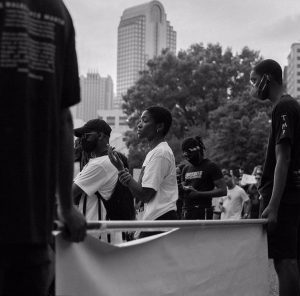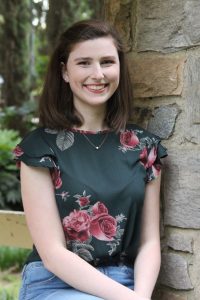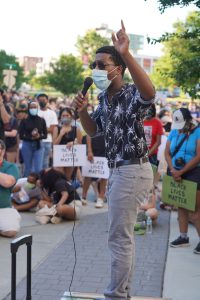Meet the new student activists
By Kayla Hallac and Abigail Welch, First Flight High (‘22) Providence Senior High (‘20)
Donating to bail funds. Signing petitions. Buying from Black-owned businesses. Creating YouTube videos with donated ad revenue. Selling art and contributing the profit. Reading books by Black authors.
In the midst of a global pandemic and protests against racial injustice, activism has occupied unique roles in high school student’s daily lives. Those no longer willing to stay silent are being forced to consider how they can contribute to their communities in new and safe ways. As a result, adapting has become key, whether that’s in person, through art or over social media.
“COVID-19 cases aren’t getting better anytime soon. They are only getting worse,” said Elijah King, Riverside High (’20). “You can still be an activist and not be out protesting. That’s not the only way to make a movement move.”
Activism is moving, even if people aren’t physically.
Fed Up with Racism

Claire Tandoh, Providence Senior High (’20), founded a student-led organization from Charlotte called Kidz Fed Up. She has been promoting different types of activism along with leading protests. Tandoh explained that “to tackle these issues, we cannot only spread awareness, we must act. You can’t really support social justice from a distance. You have to be all-in. You can’t be half involved.”
Tandoh addressed a slew of opportunities for people who aren’t on the streets, insisting that action is key, even if it is behind the scenes.
“You can be a visionary, someone who comes up with ideas,” Tandoh said. “A healer, someone who is there to support and nurture. A builder, someone who puts the ideas in motion. There are so many more roles. You don’t just have to be an organizer.”
Tandoh has her organization’s Instagram platform to provide information about times and locations for protestors, links to various funds for donors and access to petitions for petitioners. She also educates people as a whole so they are aware of the many options available to get involved.
Regardless of the pandemic, Tandoh pushes action with her followers. She explains that while she wears a mask whenever she protests and encourages other people to do the same, solely posting black screens on social media isn’t an option for her. For Tandoh, there is a clear difference between passive reposting and active educating, petitioning, and donating.
“Although we might not be able to leave our houses, for Black people, especially Black women, the Coronavirus is killing us disproportionately. Racism in America is killing us as well,” Tandoh said.
Ultimately, Black Lives Matter is “more than a movement. It is a livelihood,” Tandoh said, and in order to make true justice a reality, it requires active participation in everyday life, not just in the moment.
An Attitude of Activity

Isabel Boston, Cary High (’20), knows what it means to adapt activism into her everyday life in a safe way.
Fibromyalgia, along with other chronic conditions, leads to constant fatigue and pain for Boston, along with a weakened immune system. While this hasn’t been a problem in the past — Boston has attended marches including March for Our Lives and the Women’s March — the threat of the pandemic has kept her home the past few weeks.
Despite this, she’s been actively contributing to the cause through monthly donations to bail funds, having conversations about racism with her neighbors and signing petitions.
“I am adjusting to my new forms of activism by just being open as possible to new ideas. I am always scrolling for new petitions, organizations and movements,” Boston said.
These behind-the-scenes forms of activism are crucial. While donating to bail funds and mass petitions might be newer ideas to high school students, the number of posts on social media explaining them, their importance and how to find legitimate places to donate has soared.
Boston is one of these students absorbing and using this information, and she explains that “I am adjusting to my new forms of activism by just being open as possible to new ideas.”
Boston maintains an attitude of strength, of knowing that she is not alone in having to help from home to maintain safety and knowing that a constant fight for racial justice can be achieved in small ways, one signature and donation at a time.
Supporting Black Lives with Bracelets

Maya Gavia, East Mecklenburg High (‘20), also has come up with an alternative to in-person protesting in order to reduce the risk of obtaining COVID-19. Gavia creates Black Lives Matter bracelets for others who donate to the cause.
“I remember reading all about George Floyd, and seeing the outrage spread across social media all while continuing to educate myself on what my role in the BLM movement should and will look like,” she said. “I saw a lot of people making drawings to sell and then put the profit towards donations. Knowing that I could only donate so much out of my own pocket, but not being satisfied with just that, I knew that I could make bracelets for the cause as well.”
Gavia was inspired by others in her community who also used art to make a statement, including in murals on the streets in cities across the country. Art has also played an important role in making racial justice a daily, family issue to face together.
“Art has just always been an important thing in my household, so using it for something bigger like this seemed like a no brainer,” Gavia said. “Donations are just one piece, like protests, to this movement, and art is a great incentive and also a way to spread the message and show support.”
Protecting Protectors

King, an activist in his Durham community, has organized the Durham Neighbors Free Lunch initiative and also organized two protests recently with 500-700 people attending. He believes protesters can stay safe while also getting involved.
“At my protest and at my initiative, everyone has to wear a mask,” King said. “To act responsibly as an organizer, your job isn’t only to make sure people leave with a message. As an organizer, your job isn’t only to be impactful. As an organizer, our job is to make sure people are staying safe and acting responsibly; we know there’s a lot of people, but can you please try to stay socially distanced? Can you please wear masks? Can you please keep your hands to yourself?”
The safety aspect of protests doesn’t stop at COVID-19; students also worry about the violence.
King feels there’s a way to remedy this by inviting medical support and unarmed de-escalation forces for the protestors before things get dangerous. By doing this, the likelihood of the protest getting too rowdy is reduced, which in turn reduces the necessity of police presence.
“If you give the police no reason to be there, it doesn’t have a chance to get violent,” King said.
Pandemic: The push to protest
Eva Flowe, Riverside High (‘21), works for the Durham Youth Climate Justice Initiative, which brings students of color in the climate justice movement, in association with North Carolina Waste Awareness and Reduction movement which fights for energy justice against Duke energy.
Flowe believes it’s a personal choice about safety for people to take part in Black Lives Matter protests; however, the three she’s been to recently have been well organized.
“I think that when I’m at the protest, the people who are there tend to be behaving much more responsibly then people who are out and about not at protests,” Flowe said.
And COVID-19 in her mind is a big part of the movement, for more than just safety reasons.
“I think the fact that so many people have been laid off, and the fact that racism has been so exposed by the disproportionate amounts of Black people who have been killed by the pandemic, really set the stage,” Flowe said.
